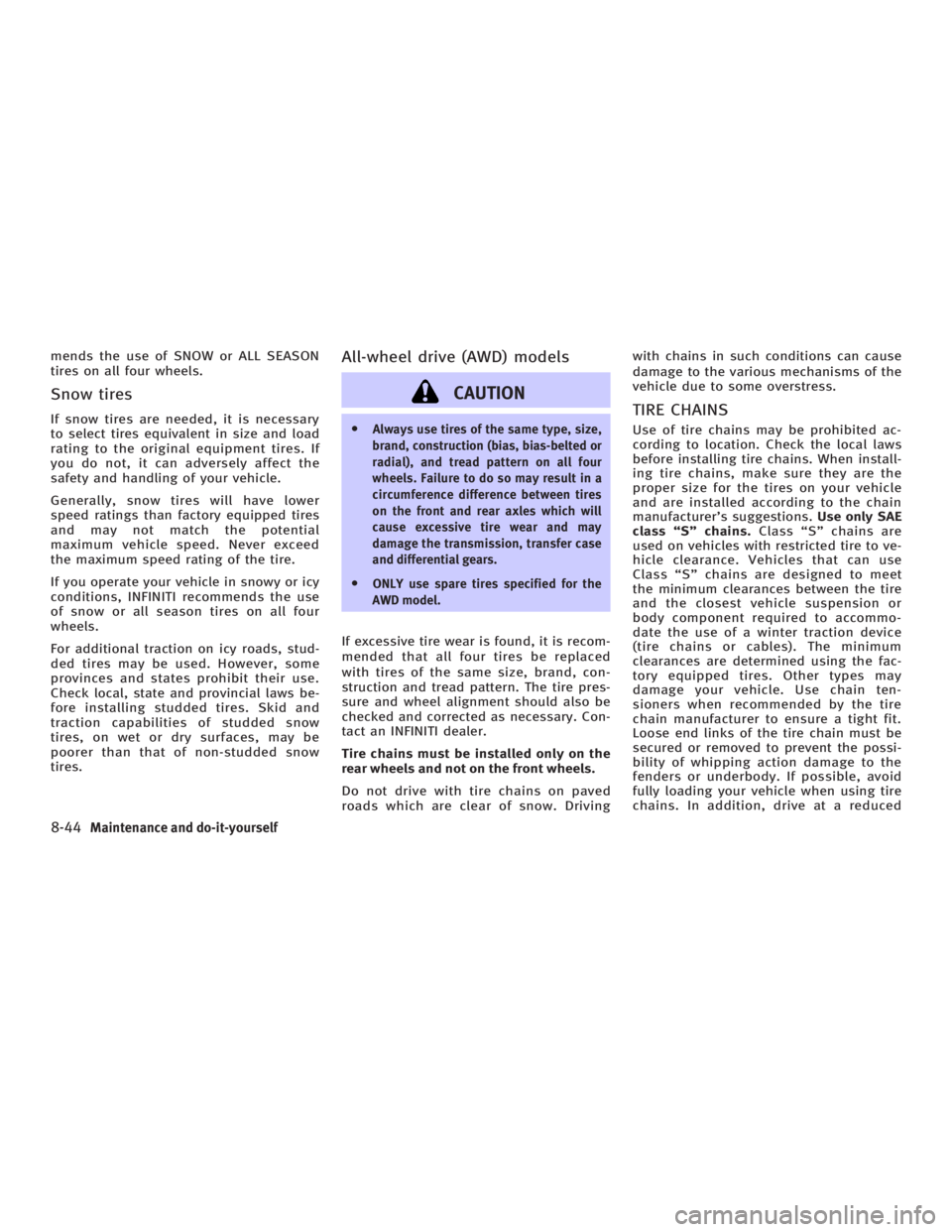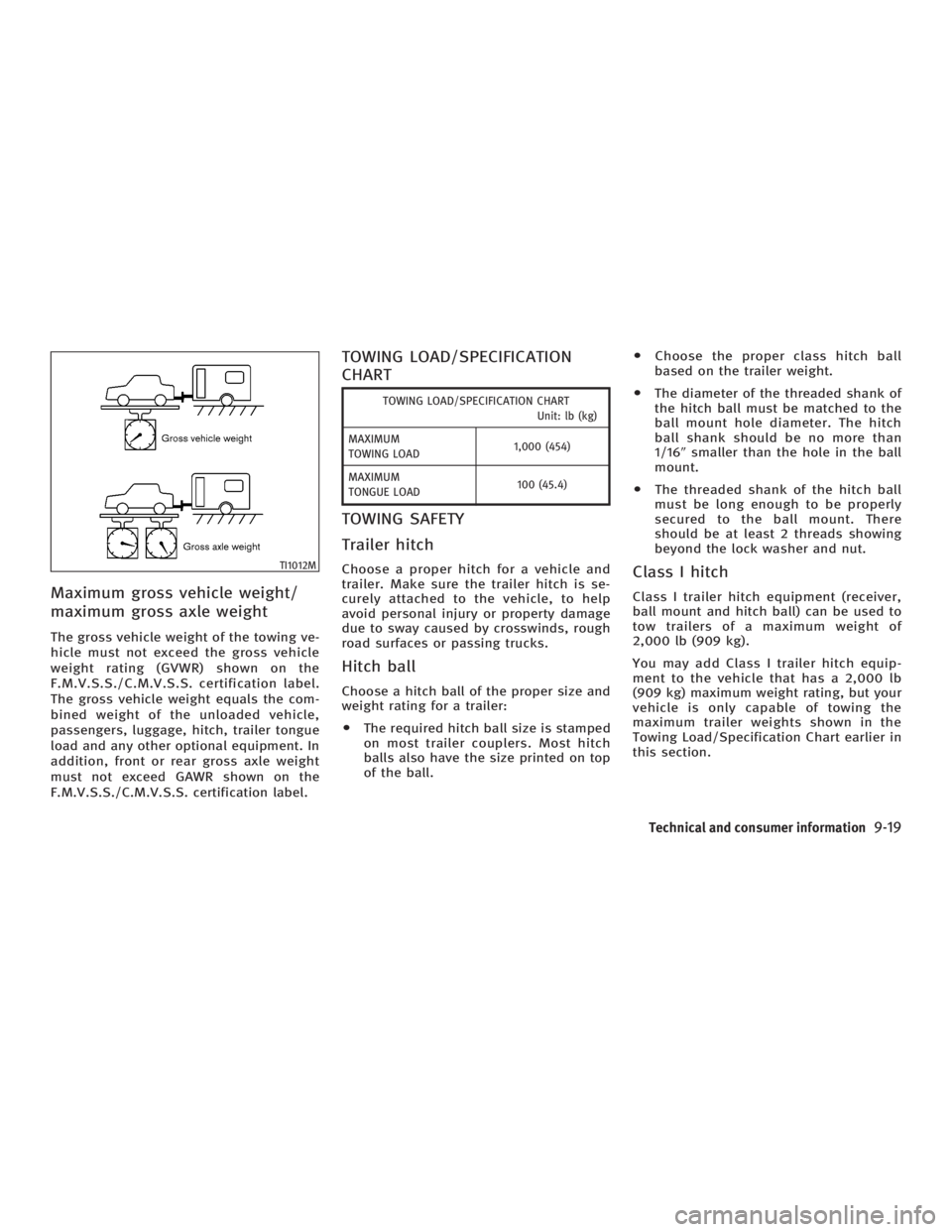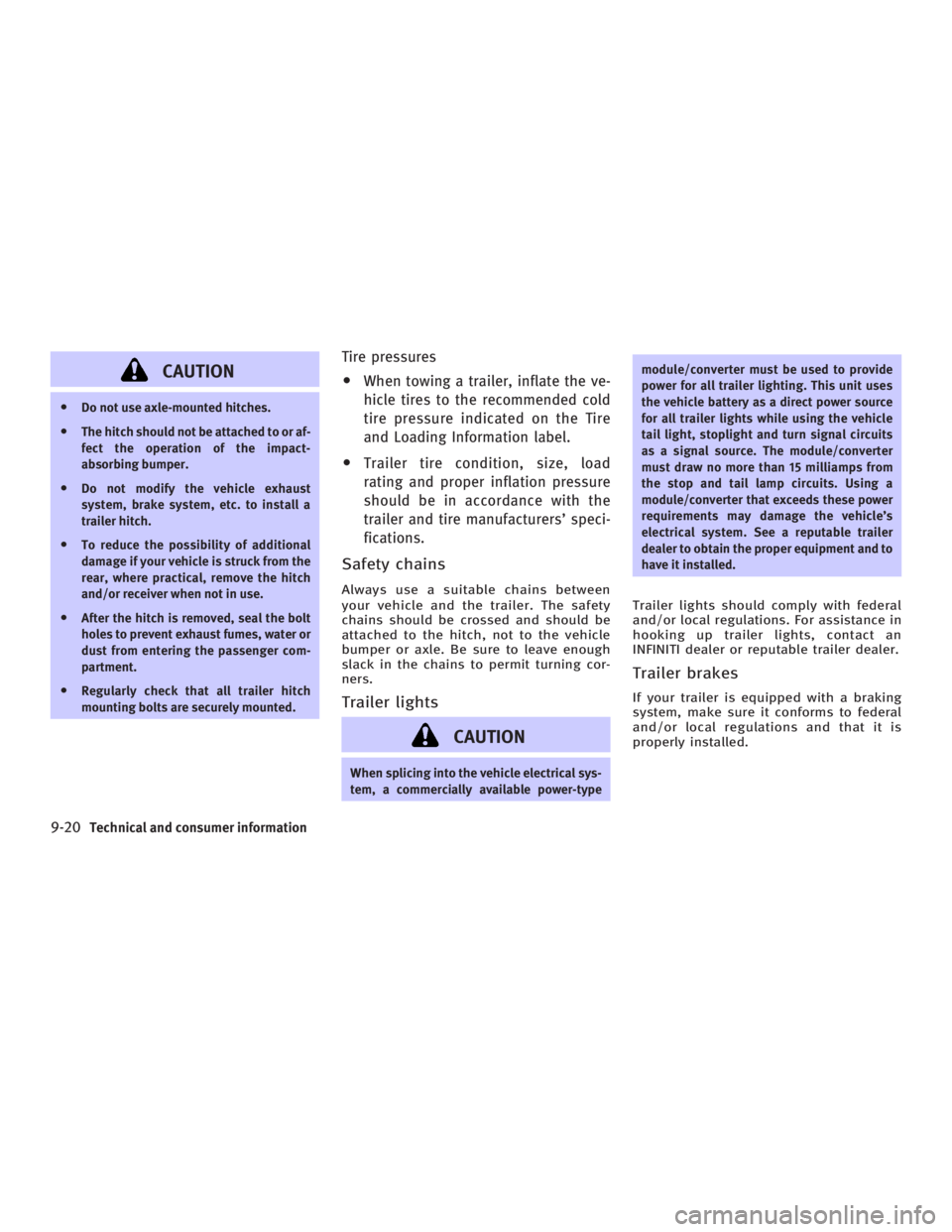2006 INFINITI G35 ECU
[x] Cancel search: ECUPage 283 of 344

Two types of fuses are used. Type
q A
is
used in the fuse boxes in the engine com-
partment. Type
q B
is used in the passen-
ger compartment fuse box.
Type
q A
fuses are provided as spare
fuses. They are stored in the passenger
compartment fuse box.
Type
q A
fuses can be installed in the en-
gine compartment and passenger com-
partment fuse boxes. If a type
q A
fuse is used to replace a type
q B
fuse, the type
q A
fuse will not be level
with the fuse pocket as shown in the il-
lustration. This will not affect the perfor-
mance of the fuse. Make sure the fuse is
installed in the fuse box securely.
Type
q B
fuses cannot be installed in the
underhood fuse boxes. Only use type
q A
fuses in the underhood fuse boxes. ENGINE COMPARTMENT
CAUTION Never use a fuse of a higher or lower am-
perage rating than that specified on the fuse
box cover. This could damage the electrical
system or cause a fire.
If any electrical equipment does not oper-
ate, check for an open fuse.
1. Be sure the ignition switch and head-
light switch are in the OFF position.SDI1751 SDI1752 SDI1392A
FUSES
Maintenance and do-it-yourself
8-25
w 06.1.4/V35-D/V5.0
X
Page 286 of 344

KEYFOB (except Intelligent Key) Replace the battery as follows:
1. Open the lid using a suitable tool
q A
. 2. Replace the battery with a new one.
Recommended battery: CR2025 or
equivalent
Make sure that the ! side faces the
bottom case.
3. Close the lid securely.
4. Push the keyfob button two or three
times to check its operation.
See an INFINITI dealer if you need any as-
sistance for replacement.
If the battery is removed for any reason
other than replacement, perform step 4
above.
O Be careful not to touch the circuit board
and the battery terminal.
O An improperly disposed battery can
harm the environment. Always confirm
local regulations for battery disposal.
O The keyfob is water-resistant; how-
ever, if it gets wet, immediately wipe it
completely dry.
O When changing batteries, do not let
dust or oil get on the keyfob. FCC Notice:
Changes or modifications not expressly
approved by the party responsible for com-
pliance could void the user's authority to
operate the equipment.
This device complies with Part 15 of the
FCC Rules and RSS-210 of Industry Canada.
Operation is subject to the following two
conditions: (1) This device may not cause
harmful interference, and (2) this device
must accept any interference received, in-
cluding interference that may cause un-
desired operation of the device.
SDI1731KEYFOB BATTERY REPLACEMENT
8-28 Maintenance and do-it-yourself
w 06.1.4/V35-D/V5.0
X
Page 287 of 344

INTELLIGENT KEY
CAUTIONBe careful not to allow children to swallow
the battery and removed parts.
Replace the battery as follows:
1. Release the lock knob at the back of
the Intelligent Key and remove the me-
chanical key. 2. Insert a flat-blade screwdriver
q A
wrapped with a cloth into the slit
q B
of the corner and twist it to separate
the upper part from the lower part.
3. Replace the battery with a new one.
O Do not touch the internal circuit and
electric terminals as it could cause a
malfunction.
Recommended battery: CR2025 or
equivalent
Make sure that the ! side faces the
bottom of the case. The ! mark is
stamped on the bottom of the case. 4. Align the tips of the upper and lower
parts, and then push them together
until it is securely closed.
5. Push the buttons two or three times to
check its operation.
See an INFINITI dealer if you need any as-
sistance for replacement.
If the battery is removed for any reason
other than replacement, perform step 5
above.
O Be careful not to touch the circuit board
and the battery terminal.
O An improperly disposed battery can
harm the environment. Always confirm
local regulations for battery disposal.
O When changing batteries, do not let
dust or oil get on the Intelligent Key.
FCC Notice:
This equipment has been tested and found
to comply with the limits for a Class B digi-
tal device pursuant to part 15 of the FCC
Rules. These limits are designed to provide
reasonable protection against harmful in-
terference in a residential installation.
This equipment generates, uses and can
radiate radio frequency energy and, if not
installed and used in accordance with theSDI1786 SDI1787
Maintenance and do-it-yourself
8-29
w 06.1.4/V35-D/V5.0
X
Page 302 of 344

mends the use of SNOW or ALL SEASON
tires on all four wheels.
Snow tires If snow tires are needed, it is necessary
to select tires equivalent in size and load
rating to the original equipment tires. If
you do not, it can adversely affect the
safety and handling of your vehicle.
Generally, snow tires will have lower
speed ratings than factory equipped tires
and may not match the potential
maximum vehicle speed. Never exceed
the maximum speed rating of the tire.
If you operate your vehicle in snowy or icy
conditions, INFINITI recommends the use
of snow or all season tires on all four
wheels.
For additional traction on icy roads, stud-
ded tires may be used. However, some
provinces and states prohibit their use.
Check local, state and provincial laws be-
fore installing studded tires. Skid and
traction capabilities of studded snow
tires, on wet or dry surfaces, may be
poorer than that of non-studded snow
tires. All-wheel drive (AWD) models
CAUTION O Always use tires of the same type, size,
brand, construction (bias, bias-belted or
radial), and tread pattern on all four
wheels. Failure to do so may result in a
circumference difference between tires
on the front and rear axles which will
cause excessive tire wear and may
damage the transmission, transfer case
and differential gears.
O ONLY use spare tires specified for the
AWD model.
If excessive tire wear is found, it is recom-
mended that all four tires be replaced
with tires of the same size, brand, con-
struction and tread pattern. The tire pres-
sure and wheel alignment should also be
checked and corrected as necessary. Con-
tact an INFINITI dealer.
Tire chains must be installed only on the
rear wheels and not on the front wheels.
Do not drive with tire chains on paved
roads which are clear of snow. Driving with chains in such conditions can cause
damage to the various mechanisms of the
vehicle due to some overstress.
TIRE CHAINS Use of tire chains may be prohibited ac-
cording to location. Check the local laws
before installing tire chains. When install-
ing tire chains, make sure they are the
proper size for the tires on your vehicle
and are installed according to the chain
manufacturer's suggestions. Use only SAE
class ªSº chains. Class ªSº chains are
used on vehicles with restricted tire to ve-
hicle clearance. Vehicles that can use
Class ªSº chains are designed to meet
the minimum clearances between the tire
and the closest vehicle suspension or
body component required to accommo-
date the use of a winter traction device
(tire chains or cables). The minimum
clearances are determined using the fac-
tory equipped tires. Other types may
damage your vehicle. Use chain ten-
sioners when recommended by the tire
chain manufacturer to ensure a tight fit.
Loose end links of the tire chain must be
secured or removed to prevent the possi-
bility of whipping action damage to the
fenders or underbody. If possible, avoid
fully loading your vehicle when using tire
chains. In addition, drive at a reduced
8-44 Maintenance and do-it-yourself
w 06.1.4/V35-D/V5.0
X
Page 323 of 344

the vehicle. That weight may not
safely exceed the available cargo
and luggage load capacity calcu-
lated in Step 4.
6. If your vehicle will be towing a
trailer, load from your trailer will be
transferred to your vehicle. Consult
this manual to determine how this
reduces the available cargo and lug-
gage load capacity of your vehicle.
Before driving a loaded vehicle, confirm
that you do not exceed the Gross Ve-
hicle Weight Rating (GVWR) or the
Gross Axle Weight Rating (GAWR) for
your vehicle. See ``Measurement of
Weights'' later in this section.
Also check tires for proper inflation
pressures. See the Tire and Loading In-
formation label.
LOADING TIPS
O The GVW must not exceed GVWR or
GAWR as specified on the F.M.V.S.S./C.M.V.S.S. certification
label.
O Do not load the front and rear axle
to the GAWR. Doing so will exceed
the GVWR.
WARNINGO Properly secure all cargo with
ropes or straps to help prevent it
from sliding or shifting. Do not
place cargo higher than the seat-
backs. In a sudden stop or colli-
sion, unsecured cargo could cause
personal injury.
O Do not load your vehicle any
heavier than the GVWR or the
maximum front and rear GAWRs. If
you do, parts of your vehicle can
break, tire damage could occur, or
it can change the way your vehicle
handles. This could result in loss
of control and cause personal
injury. O Overloading not only can shorten
the life of your vehicle and the tire,
but can also cause unsafe vehicle
handling and longer braking dis-
tances. This may cause a prema-
ture tire failure which could result
in a serious accident and personal
injury. Failures caused by over-
loading are not covered by the ve-
hicle's warranty.
MEASUREMENT OF WEIGHTS
Secure loose items to prevent weight
shifts that could affect the balance of
your vehicle. When the vehicle is
loaded, drive to a scale and weigh the
front and the rear wheels separately to
determine axle loads. Individual axle
loads should not exceed either of the
gross axle weight ratings (GAWR). The
total of the axle loads should not ex-
ceed the gross vehicle weight rating
(GVWR). These ratings are given on the
vehicle certification label. If weight rat-
ings are exceeded, move or remove
items to bring all weights below the rat-
ings. Technical and consumer information
9-17
w 06.1.4/V35-D/V5.0
X
Page 325 of 344

Maximum gross vehicle weight/
maximum gross axle weight The gross vehicle weight of the towing ve-
hicle must not exceed the gross vehicle
weight rating (GVWR) shown on the
F.M.V.S.S./C.M.V.S.S. certification label.
The gross vehicle weight equals the com-
bined weight of the unloaded vehicle,
passengers, luggage, hitch, trailer tongue
load and any other optional equipment. In
addition, front or rear gross axle weight
must not exceed GAWR shown on the
F.M.V.S.S./C.M.V.S.S. certification label. TOWING LOAD/SPECIFICATION
CHART TOWING LOAD/SPECIFICATION CHART
Unit: lb (kg)
MAXIMUM
TOWING LOAD 1,000 (454)
MAXIMUM
TONGUE LOAD 100 (45.4)
TOWING SAFETY
Trailer hitch Choose a proper hitch for a vehicle and
trailer. Make sure the trailer hitch is se-
curely attached to the vehicle, to help
avoid personal injury or property damage
due to sway caused by crosswinds, rough
road surfaces or passing trucks.
Hitch ball Choose a hitch ball of the proper size and
weight rating for a trailer:
O The required hitch ball size is stamped
on most trailer couplers. Most hitch
balls also have the size printed on top
of the ball. O Choose the proper class hitch ball
based on the trailer weight.
O The diameter of the threaded shank of
the hitch ball must be matched to the
ball mount hole diameter. The hitch
ball shank should be no more than
1/16 0 smaller than the hole in the ball
mount.
O The threaded shank of the hitch ball
must be long enough to be properly
secured to the ball mount. There
should be at least 2 threads showing
beyond the lock washer and nut.
Class I hitch Class I trailer hitch equipment (receiver,
ball mount and hitch ball) can be used to
tow trailers of a maximum weight of
2,000 lb (909 kg).
You may add Class I trailer hitch equip-
ment to the vehicle that has a 2,000 lb
(909 kg) maximum weight rating, but your
vehicle is only capable of towing the
maximum trailer weights shown in the
Towing Load/Specification Chart earlier in
this section.TI1012M
Technical and consumer information
9-19
w 06.1.4/V35-D/V5.0
X
Page 326 of 344

CAUTIONO Do not use axle-mounted hitches.
O The hitch should not be attached to or af-
fect the operation of the impact-
absorbing bumper.
O Do not modify the vehicle exhaust
system, brake system, etc. to install a
trailer hitch.
O To reduce the possibility of additional
damage if your vehicle is struck from the
rear, where practical, remove the hitch
and/or receiver when not in use.
O After the hitch is removed, seal the bolt
holes to prevent exhaust fumes, water or
dust from entering the passenger com-
partment.
O Regularly check that all trailer hitch
mounting bolts are securely mounted. Tire pressures
O When towing a trailer, inflate the ve-
hicle tires to the recommended cold
tire pressure indicated on the Tire
and Loading Information label.
O Trailer tire condition, size, load
rating and proper inflation pressure
should be in accordance with the
trailer and tire manufacturers' speci-
fications.
Safety chains Always use a suitable chains between
your vehicle and the trailer. The safety
chains should be crossed and should be
attached to the hitch, not to the vehicle
bumper or axle. Be sure to leave enough
slack in the chains to permit turning cor-
ners.
Trailer lights
CAUTION When splicing into the vehicle electrical sys-
tem, a commercially available power-type module/converter must be used to provide
power for all trailer lighting. This unit uses
the vehicle battery as a direct power source
for all trailer lights while using the vehicle
tail light, stoplight and turn signal circuits
as a signal source. The module/converter
must draw no more than 15 milliamps from
the stop and tail lamp circuits. Using a
module/converter that exceeds these power
requirements may damage the vehicle's
electrical system. See a reputable trailer
dealer to obtain the proper equipment and to
have it installed.
Trailer lights should comply with federal
and/or local regulations. For assistance in
hooking up trailer lights, contact an
INFINITI dealer or reputable trailer dealer.
Trailer brakes If your trailer is equipped with a braking
system, make sure it conforms to federal
and/or local regulations and that it is
properly installed.
9-20 Technical and consumer information
w 06.1.4/V35-D/V5.0
X
Page 327 of 344

WARNINGNever connect a trailer brake system directly
to the vehicle brake system.
Pre-towing tips O Be certain your vehicle maintains a
level position when a loaded and/or
unloaded trailer is hitched. Do not
drive the vehicle if it has an abnormal
nose-up or nose-down condition;
check for improper tongue load, over-
load, worn suspension or other pos-
sible causes of either condition.
O Always secure items in the trailer to
prevent load shifts while driving.
O Load the trailer so approximately 60%
of the trailer load is in the front half
and 40% is in the back half.
O Check your hitch, trailer tire pressure,
vehicle tire pressure, trailer light op-
eration, and trailer wheel lug nuts
every time you attach a trailer to the
vehicle.
O Be certain your rear view mirrors con-
form to all federal, state or local regula- tions. If not, install any mirrors required
for towing before driving the vehicle.
Trailer towing tips In order to gain skill and an under-
standing of the vehicle's behavior, you
should practice turning, stopping and
backing up in an area which is free from
traffic. Steering stability, and braking per-
formance will be somewhat different than
under normal driving conditions.
O Always secure items in the trailer to
prevent load shift while driving.
O Avoid abrupt starts, acceleration or
stops.
O Avoid sharp turns or lane changes.
O Always drive your vehicle at a mod-
erate speed. Some states or provinces
have specific speed limits for vehicles
that are towing trailers. Obey the local
speed limits.
O When backing up, hold the bottom of
the steering wheel with one hand.
Move your hand in the direction in
which you want the trailer to go. Make
small corrections and back up slowly.
If possible, have someone guide you
when you are backing up. O Always block the wheels on both vehicle
and trailer when parking. Parking on a
slope is not recommended; however, if
you must do so, and if your vehicle is
equipped with automatic transmission,
first apply the parking brake and block
the wheels, and then move the transmis-
sion selector lever into the P (Park) posi-
tion. If you move the selector lever to
the P (Park) position before applying the
parking brake and blocking the wheels,
transmission damage could occur.
O When going down a hill, shift into a
lower gear and use the engine braking
effect. When going up a long grade,
downshift the transmission to a lower
gear and reduce speed to reduce
chances of engine overloading and/or
overheating.
However, for long steep grades, do
not stay in 1st or 2nd gear when
driving above 35 MPH (56 km/h).
O If the engine coolant rises to an ex-
tremely high temperature when the air
conditioning system is on, turn off the
air conditioner. Coolant heat can be
additionally vented by opening the
windows, switching the fan control to
high and setting the temperature con-
trol to the HOT position.
Technical and consumer information
9-21
w 06.1.4/V35-D/V5.0
X